Outforia Quicktake: Key Takeaways
- Joshua Tree National Park is unique for its abundance of accessible wilderness areas and diverse outdoor recreation opportunities.
- The park, just under 800,000 acres in size, is home to two desert ecosystems, the Mojave Desert and the Colorado Desert.
- Approximately 2.8 million visitors come each year, with the busy season from October to May, and popular activities include rock climbing, biking, star gazing, birding, horseback riding, photography, hiking, and camping.
- Joshua Tree National Park offers a range of hiking trails for different skill levels, as well as stunning locations for photography and scenic drives for those less inclined to hike.

Joshua Tree National Park in southern California is unique in the national park system for its abundance of easily accessible wilderness areas and ample opportunities for outdoor recreation of all kinds. With so much that can be seen and done in Joshua Tree National Park, we’ve put together the ultimate guide to inspire your wanderlust and help you plan your trip to Joshua Tree.
Joshua Tree National Park is located about two and a half hours east of Los Angeles and within easy driving distance of San Diego and Las Vegas. Joshua Tree was established by President Franklin Delano Roosevelt in 1936 as a National Monument, and later became a National Park in 1994.
Joshua Tree National Park is just under 800,000 acres (323,748.51 ha), which is about the size of Rhode Island. Over half of Joshua Tree National Park is designated as wilderness. Joshua Tree is unique because it holds two desert ecosystems, the Mojave Desert and the Colorado Desert, and provides a glimpse at the transition between the two.
Approximately 2.8 million visitors come each year, with the busy season running from October to May. Joshua Tree National Park is one of the few national parks that is actually better to visit in the winter than it is in the summer. The opportunities for outdoor recreation seem endless, with Joshua Tree providing a popular location for rock climbing, biking, star gazing, birding, horseback riding, photography, hiking, and camping. We’ll cover some of the most popular and accessible recreation opportunities in Joshua Tree to help you experience the unique wilderness this national park has to offer.
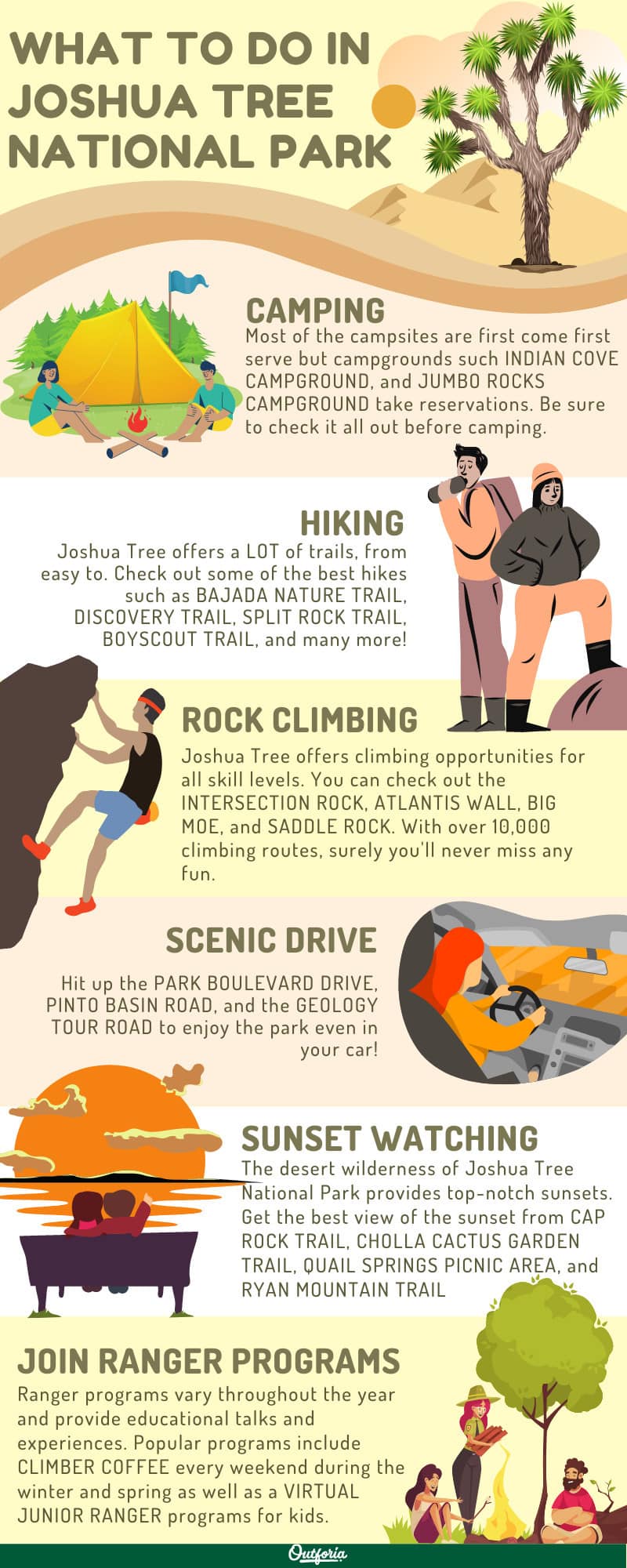
Share this image on your site
<a href="https://outforia.com/what-to-do-in-joshua-tree/"><img style="width:100%;" src="https://outforia.com/wp-content/uploads/2022/02/what-to-do-in-joshua-tree-410x1024.jpg"></a><br>What to do in Joshua Tree <a href="https://outforia.com">Outforia</a>
Best Things to Do in Joshua Tree
Things To Do In Joshua Tree for Seniors

Scenic drives and visitor centers are great options for seniors with concerns about the extreme weather. A few trails are recommended by the National Park Service as being optimized for visitors with mobility concerns, including the Bajada Nature Trail, Cap Rock Nature Trail, Oasis of Mara Trail, and the Lower Keys View Overlook.
Things To Do in Joshua Tree for Kids

The Discovery Trail is a family-friendly hike, specifically built for kids and by kids with plenty of signs to call out interesting rocks and other features along the trail. Most of the visitor centers include educational experiences geared towards kids, and the Junior Ranger program is a great way for kids to learn about and experience Joshua Tree National Park. Depending on the age of the kids, the trails rated ‘easy’ are great family-friendly options.
Things To Do in Joshua Tree for Day Visitors

If you’ll only have a day in Joshua Tree National Park, we recommend starting with a scenic drive and seeing where the day takes you. Parking lots for popular hikes can fill up fast during the park’s busy season. If you have a limited time in the park but still want to get out on a trail, starting with a drive and stopping at trailheads that still have parking spots available will allow you to experience Joshua Tree without waiting in line for a spot to open up.
Having a little flexibility in your plans will leave space for Joshua Tree to surprise you, with trails you wouldn’t have known to choose but lead to great views, interesting vegetation, and out of this world geology!
Things To Do in Joshua Tree for All Seasons

Weather is the biggest seasonal concern of visiting Joshua Tree. Temperatures can be high and the dry desert environment makes outdoor recreation potentially hazardous. If you’re visiting Joshua Tree National Park between October and May, try getting out on the trails and experiencing the wilderness of Joshua Tree. Be sure to check weather forecasts or channels before heading out to know the type of weather for the day and bring appropriate food and hydration. If you’re visiting Joshua Tree National Park in the summer months, starting with the scenic drives and visitor centers might be your best bet.
Weather conditions can be too extreme for any hikes rated moderate or challenging, so be prepared for shorter outings and frequent breaks from the heat.
Joshua Tree Trails:
Longest, Shortest, and Most Popular
California Riding and Hiking Trail

The longest trail in Joshua Tree National Park is the California Riding and Hiking Trail, with a total distance of 35 miles (56.32 km). It would take two to three days to hike the whole trail, but there are multiple trailheads along the way and it’s possible to hike the trail in small sections.
The California Riding and Hiking Trail takes you through the Mojave Desert from the Black Rock Canyon to the North Entrance of the park. This trail should not be attempted during the summer or when weather is hot because of high risk of sun exposure, dehydration, and extreme temperatures.
Cottonwood Spring Trail

The shortest trail in the park is the Cottonwood Spring Trail, with a distance of 0.1 miles (0.16 km) and a total time of approximately ten minutes. The Cottonwood Spring Trail leads to a fan palm oasis and is a great place to do some birding in the shade.
Barker Dam Trail

There are many popular trails in Joshua Tree National Park. One of the most popular day hikes is the Barker Dam Trail. Barker Dam is often crowded with limited parking, but is worth it for both the history of this part of the park and a rare view of natural water sources within Joshua Tree National Park. On the Barker Dam Trail you can view a historic water tank built by early cattle ranchers and is a great place to view the park’s desert bighorn sheep. This loop trail is 1.1 miles (1.77 km) long with an elevation gain of fifty feet (15.24 m) and is estimated to take an hour to complete.
9 Best Hikes in Joshua Tree National Park
We’ve pulled together some of the top hikes in Joshua Tree National Park to feature in our guide, organized by difficulty rating. To view all the trails in Joshua Tree, visit the NPS database.
Easy Hikes
The following featured hikes are rated as Easy by the National Park Service and are recommended year-round, with some being paved and wheelchair accessible. While these trails are rated for year-round use, if you’ll be visiting in the summer it’s recommended to start your hike before 9 a.m. to avoid the extreme heat.
1. Bajada Nature Trail

The Bajada Nature Trail is an easy path that showcases the plants found in the Colorado Desert ecosystem. The trailhead is located south of the Cottonwood Visitor Center, half a mile north of the South Entrance. This loop trail has a distance of a quarter mile, with 20 feet (6.09 m) elevation gain. It’s estimated to take fifteen to twenty minutes to complete the loop.
2. Discovery Trail

The Discovery Trail takes you to Skull Rock and is an easy hike through boulder piles and desert washes. The trailhead is located at the Skull Rock parking area, just east of Jumbo Rocks Campground. This loop trail is 0.7 miles (1.12 km) long, with an elevation gain of seventy feet (21.33 m). It’s estimated to take thirty to forty-five minutes to complete the loop.
3. Keys View Trail

The Keys View Trail is a paved loop path with views of the San Andreas Fault, Mount San Jacinto, Mount San Gorgonio, and the Salton Sea. The loop is 0.6 miles (0.96 km) long with an elevation gain of twenty-five feet (7.62 m). It’s estimated to take thirty minutes to complete.
Moderate Hikes
The following features hikes are rated as Moderate by the National Park Service for their longer distances and more intense elevation gain and unpaved trail conditions. These trails may not be recommended for summer due to the time spent in the heat, so check weather conditions before setting out on these trails.
4. Split Rock Trail

The Split Rock Trail starts by the Live Oak Picnic Area and takes you past Face Rock, one of Joshua Tree National Park’s iconic geologic features. This loop trail is two and a half miles (4.02 km) long, with an elevation gain of 150 feet (45.72 m). It’s estimated to take 1.5 to 2.5 hours to complete the loop.
5. West Side Loop Trail

The West Side Loop Trail goes through the ridge and desert washes west of the Black Rock Campground, with the trailhead located at Black Rock Campground. The loop trail is 4.7 miles (7.56 km) long with an elevation gain of 785 feet (239.26 km), estimated to take 2.5 to 4 hours to complete.
6. Hi-View Trail

The Hi-View Trail leads you up a steep ridge to the western side of the park, with panoramic views of the Joshua tree forests. There are some steep sections along the trail, but there are also plenty of benches to take a break and enjoy the view. The trailhead is located northwest of the Black Rock Campground. The loop trail is 1.3 miles (2.09 km) long if you start at the parking area and 3 miles (4.82 km) long if you start at the Black Rock Nature Center, with an elevation gain of 400 feet (121.92 m).
Challenging Hikes
The following features hikes are rated as Challenging by the National Park Service due to their length and intensity and should NOT be attempted in the summer.
7. Boyscout Trail

The Boy Scout Trail is one of the best trails in Joshua Tree National Park for backpacking and a true wilderness experience. This is a one way trail, eight miles (12.87 km) in length with an elevation gain of 1190 feet (362.71 m). Due to the length, it’s recommended for hikers to set up a vehicle shuttle to be dropped off at one end and picked up at the other, as the hike is too strenuous to go out and back in one day. The Boy Scout Trail is a popular backpacking trip and can turn into a two day event, but taking the trail one way is anticipated to take six hours. The south end of the trail is just inside the West Entrance and the north end of the Boy Scout Trail is at Indian Cove. Most hikers completing this trail one-way in a day choose to start at the southern end and finish at Indian Cove.
8. Ryan Mountain Trail

The Ryan Mountain Trail takes you to the summit of Ryan Mountain and is one of the most popular hikes in the park. The trailhead is located at the parking area between Sheep Pass and Ryan Campground. This out and back trail is 3 miles (4.82 km) long with an elevation gain of 1050 feet (320.04 m) and is estimated to take 1.5 to 2.5 hours to complete
9. Fortynine Palms Oasis

The Fortynine Palms Oasis takes you up and over a ridge to descend into a fan palm oasis in a rocky canyon. The trailhead is located at the Fortynine Palms parking area off Highway 62. This out and back trail is three miles in (4.82 km) length with an elevation gain of 300 feet (91.44 m).
Safety Tips for Hiking in Joshua Tree

Even a short hike in Joshua Tree can experience unexpected problems, mostly due to the wilderness nature of the park and the potential for extreme weather conditions. Here are a few safety tips for hiking in Joshua Tree.
Best Places to Watch the Sunset in Joshua Tree
The desert wilderness of Joshua Tree National Park provides top-notch sunsets almost every night. Wherever you are in the park, take a moment at dusk to enjoy the sunset view across the desert. But if you plan ahead, you can pair the sunset with an exceptional view by taking one of the viewpoints mentioned below. But be sure to keep safety in mind wherever you watch the sunset from to be sure you can return to your car in the dark without any trouble.

At sunset, the Cap Rock Trail shows the setting sun over the park’s classic Joshua trees. The trailhead is located at the junction of Park Boulevard and Keys View Road. This loop trail is 0.4 miles (0.64 km) long with an elevation gain of about twenty feet (7.62 m) and is estimated to take thirty to forty-five minutes to complete.

The Cholla Cactus Garden Trail gives another classic desert view that is stunning at dusk as the sun sets over the cholla cacti. The trailhead is located twenty miles ( 40.23 km) north of the Cottonwood Visitor Center. This loop trail is 0.25 miles (0.40 km) long, with an elevation gain of ten feet (3.04 m) and is estimated to take fifteen to thirty minutes to complete.
For a seated view, check out the Quail Springs Picnic Area in the evening to be rewarded with a view of the sun setting over some of Joshua Tree’s classic rock formations.

If you’re up for a twilight hike, head up the Ryan Mountain Trail in time to reach the summit just before the sun sets for a bird’s eye view of the sunset over the desert. If you choose this route, be careful on the hike back down as the desert can get dark very quickly! Bring a flashlight or headlamp to help you reach the bottom of the mountain safely.
Scenic Drives in Joshua Tree National Park
While the hiking in Joshua Tree National Park is excellent, you don’t necessarily have to get out of your car to experience the park’s beauty. We’ve rounded up a few featured scenic drives to get you started on your trip. Even if you are planning to focus on hiking and other outdoor recreation during your time in Joshua Tree, these scenic drives are a great addition and shouldn’t be missed!
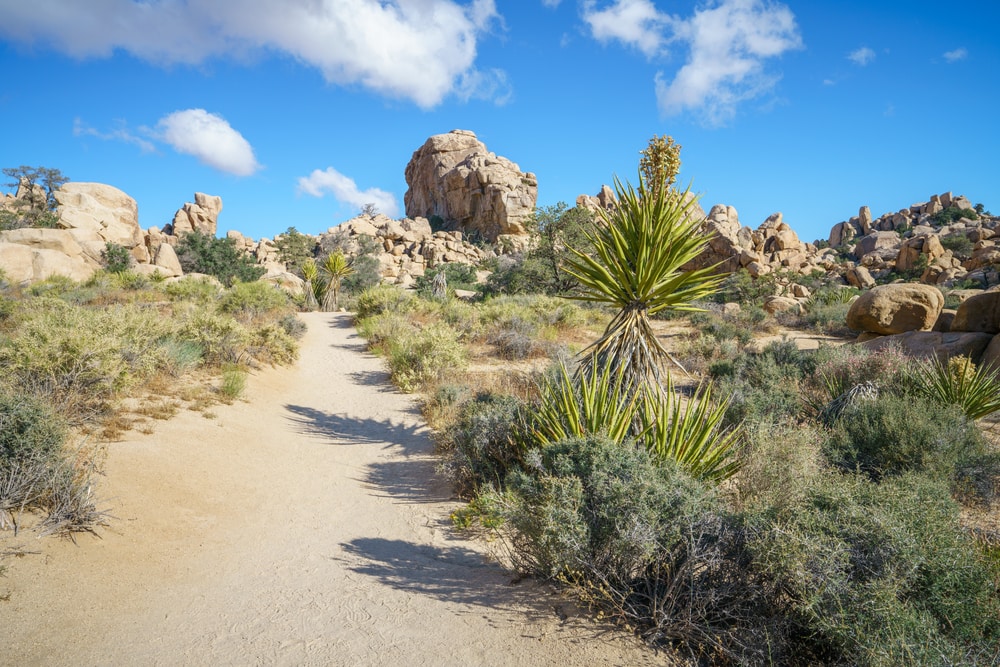
To hit all the highlights of Joshua Tree National Park, try the Park Boulevard drive. This loop is 35 miles (56.32 km) in length, but the amount of time it takes to complete depends on how many stops you make. Along the way you can stop at Hidden Valley, Cap Rock, Ryan Mountain, and Skull Rock. Short detours will connect you to Keys View and Barker Dam. To take the Park Boulevard drive, you can enter from the north entrance near Twentynine Palms or from the west entrance near the town of Joshua Tree.

For unbeatable desert views, try the Pinto Basin Road. This scenic drive takes you through the transition between the Mojave Desert ecosystem and the Colorado Desert ecosystem. This drive is 30 miles (48.28 km) long and starts at the Cottonwood Visitor Center.

If you’re up for some off-roading, try the Geology Tour Road. This 18-mile (28.96 km) round-trip road is in the backcountry, requiring four-wheel drive vehicles. You’ll descend 1,000 feet (304.8 m) into a dry lake bed with abandoned gold mines, eroding mountains, a volcanic hill, and prehistoric Indian campsites. Along the way you can stop at Malapai Hill to see Balance Rock.
You may also like: Check out all the 63 National Parks in the US: Complete with Images, Description, and More!
Camping in Joshua Tree

Joshua Tree National Park doesn’t have hotels or other lodging inside the park, so if you want to stay overnight you’ll be doing some camping. Most of the campgrounds in the park are first come first serve, although some campsites take reservations. Black Rock Campground, Indian Cove Campground, and Jumbo Rocks Campground take online reservations
There are limited camping locations, but if campsites in the national park are full there are additional sites on adjacent Bureau of Land Management Land.
If you’re camping inside Joshua Tree National Park, the National Park Service asks you to follow a few guidelines including keeping pets on a leash, only having fires in designated locations, storing food securely, and a maximum of six people per campsite.
Backpacking and camping in the wilderness section of the park and not at campgrounds is allowed. If you’ll be backpacking, you’ll need to register at the backcountry registration board. This lets park rangers know approximately what your backpacking plans are in an effort to find you more quickly should something go wrong. Backpacking is not recommended in the summer months.
You may also like: Check Out These Best Camping Places in Michigan You Shouldn’t Miss
Rock Climbing in Joshua Tree

Joshua Tree National Park is one of the top locations in the United States for both top rope and bouldering, providing climbing opportunities for all skill levels. The milder temperatures from October to May provide winter climbing opportunities when other parks get too cold and blustery. There are over 10,000 climbing routes with options for beginner climbers, professionals, and everything in between.
If you want to dip your toe in the climbing scene, join a Ranger-led Climbers Coffee program on weekend mornings from October to May. If you’re looking to get some experience, bouldering opportunities for all skill levels can be found just steps off most hiking trails. You could also hire a certified guide for a few hours or a few days to literally show you the ropes.
If you’re a beginner, some of the best climbing can be found at Intersection Rock, Quail Springs Rock, Atlantis Wall, and Thin Wall. If you have more experience and are looking for a challenge, check out Big Moe, Lost Horse Wall, and Saddle Rock.
Many bouldering routes for beginners don’t require any gear. If you are trying more challenging routes and need to rent gear, Joshua Tree Outfitters can set you up with everything you’ll need.
Best Photographs in Joshua Tree
Joshua Tree is a photographer’s dream with its unique geology, desert ecosystem, and beautiful sunsets and night sky. Here are a few of our favorite Joshua Tree photographs to spike your wanderlust!




National Park Visitor Center Locations

Joshua Tree National Park has four visitor centers, with their locations, services, and amenities outlined below.
The Joshua Tree Visitor Center is located near the park’s west entrance in the village of Joshua Tree. Amenities include exhibits, bookstore, cafe, toilets, public telephone, and showers.
The Oasis Visitor Center is located in Twentynine Palms at the Oasis of Mara. Amenities include exhibits, bookstore, water, toilets, and picnic tables.
The Cottonwood Visitor Center is located near the park’s south entrance. Amenities include exhibits, bookstore, water, toilets, and picnic area.
The Black Rock Nature Center is located in the Black Rock Campground. Amenities include bookstore, water, toilets, and picnic area.
You may also like: 10 Popular Arizona National Parks and Activities You’ll Find
Ranger Programs
Ranger programs vary throughout the year and provide educational talks and experiences tied to the natural history, geology, hiking, and other unique features in the park. The visitor centers can provide information about the ranger programs happening during your visit. Popular programs include Climber Coffee every weekend during the winter and spring, as well as a Virtual Junior Ranger Program that kids can experience both at home and while visiting the park.
Wildlife in Joshua Tree National Park
The two desert ecosystems in Joshua Tree provide seemingly endless opportunities to observe the native plants, animals, and birds.
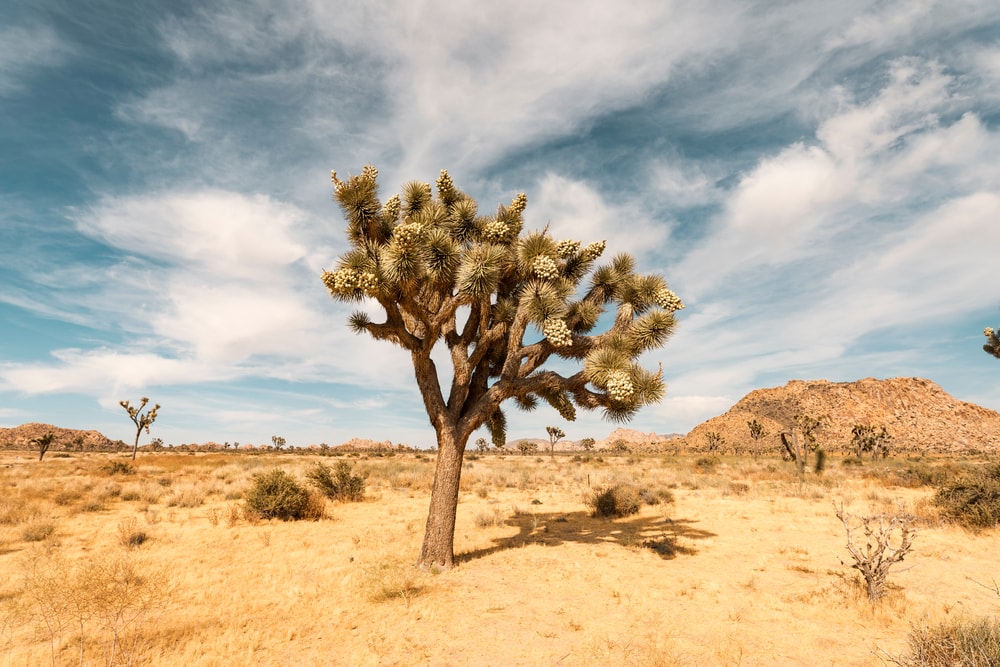
First and foremost, we have the Joshua Trees the park was named for. Joshua trees are actually not trees at all, but a species of yucca which are succulents. Joshua trees grow three to nine feet (0.91 m to 2.74 ) tall before forming branches that end clusters of spiky leaves and round, white flowers. Joshua trees can grow up to seventy feet tall (21.33 m), but are more likely to be seen between twenty and forty feet (6.09 m and 12.19 m) tall.


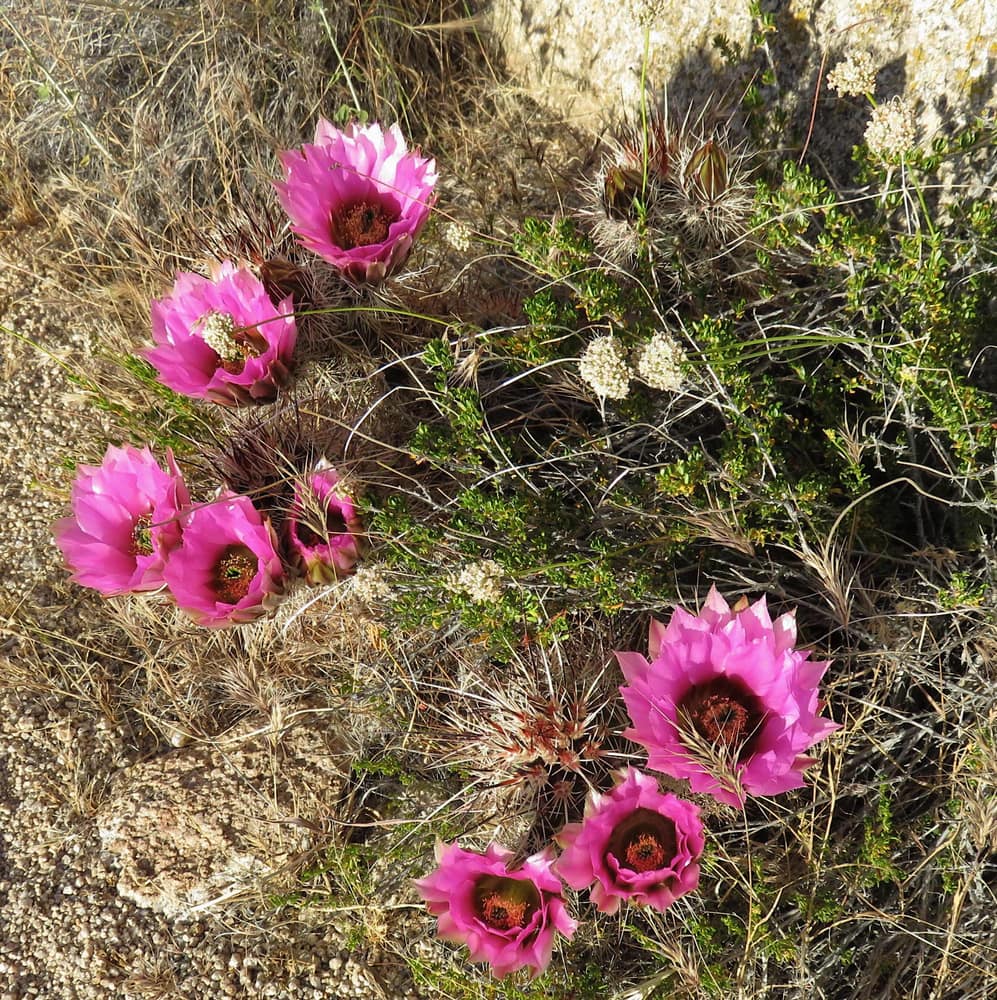


In the spring you can’t miss the wildflowers and blooming cacti all throughout the park. Wildflowers that can be seen include desert willow, dune primrose, mariposa lily, Mojave aster, Indian paintbrush, and many more. Flowering cacti include barrel, beavertail, calico, claret cup, and silver cholla. The best dates to observe the spring bloom depend on the elevation in that part of the park and change yearly depending on weather conditions.

The desert tortoise is a threatened species that can be seen throughout the park. Desert tortoises can live to be more than eighty years old and thrive in the dry, warm conditions of the park. However, invasive and non-native grass species threaten the desert tortoise by taking over the native grass species they diet depends on.
Joshua Tree National Park is a desert after all, and many creatures in the park are venomous. The warm and dry climate is ideal for rattlesnakes, scorpions, and black widow spiders. Whether you’re in the backcountry or a picnic area, watch your step and be careful where you place your hands when out and about in the park.
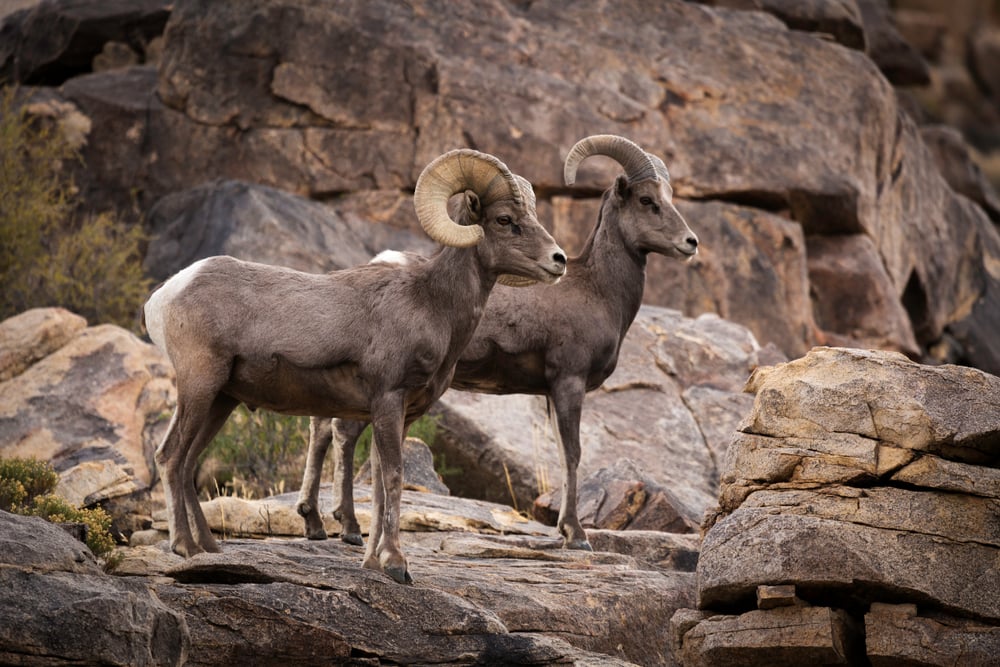
Joshua Tree National Park is one of the best places to observe desert bighorn sheep. The unique geology and dry conditions create the perfect habitat for desert bighorn sheep.
More than 250 species of birds have been observed in Joshua Tree National Park, with 78 native species nesting and raising young inside the park. The best birding locations in the park are tucked away in fan palm oases and other well-shaded areas that protect the young birds from the harsh conditions.
You may also like: Discover The Different Types of Ecosystems Across the Globe and Learn Their Importance: Complete with Images, Facts, and More!
Joshua Tree Map Link

The National Park Service has put together an interactive map of Joshua Tree’s trails, which can be found here.
Park Myths and History

The arid desert and geologic features have given Joshua Tree National Park and the surrounding area a spiritual mystique since before the park was formed. The area used to be home to miners and ranchers and was often used as a set location for western movies. Joshua Tree was a popular photoshoot location for rock albums in the 1970s and is well known as the location for the cover shoot of the first Eagles album. With Coachella Valley nearby, Joshua Tree is a popular location for musicians and artists even to this day.
You may also like: Check Out These 20 Amazing Waterfalls in Tennessee and Start Planning Your Next Adventure
Links to Park Guidebooks
We’ve pulled together a few of the top digital guidebooks to make planning your trip to Joshua Tree National Park even easier.








